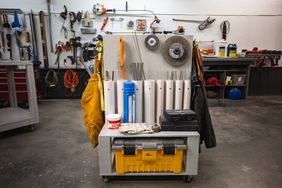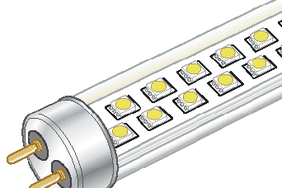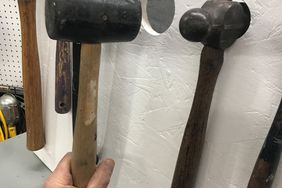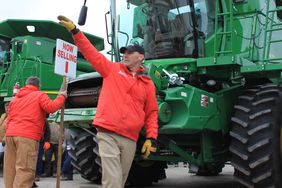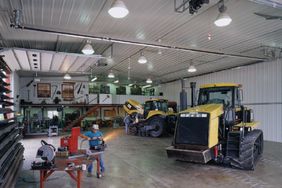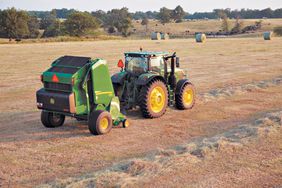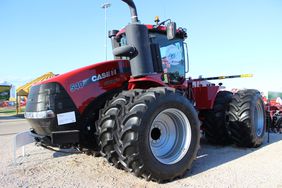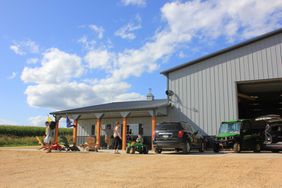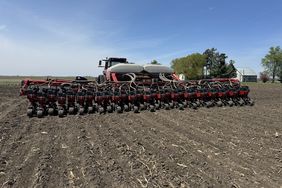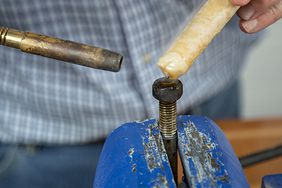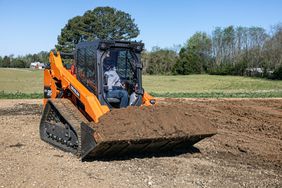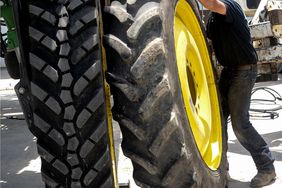:max_bytes(150000):strip_icc()/231-2-6829fe46a73b441d8d14653672389e91.jpg)
Increase shop functionality with these innovative ideas. Sponsored by Morton Buildings.
Bolt Bin on Wheels
:max_bytes(150000):strip_icc()/231-2-6829fe46a73b441d8d14653672389e91.jpg)
A major trend in shop usage features workbenches riding on wheels so they can be pushed to where the work is. Neal Pavlish of Crete, Nebraska, took this concept a step further by also mounting his bolt bin on a frame equipped with caster wheels. This allows him to push a wealth of fasteners to where they're needed on his massive shop floor.
Swinging Jib for Cords, Hoses
:max_bytes(150000):strip_icc()/two-2-2000-ac93619b24f74807a5fa634e02e89ac1.jpg)
Electrical cords and air hoses lying across a shop floor can be a tripping hazard or impediment for rolling workbenches. So Lloyd Gordon of Wellington, Ohio, fashioned a swinging jib that holds cord and hose reels at the end of its mast. That mast was made of 3x3 and 21/2x21/2-inch tube steel. The 21/2-inch tube steel slides in and out inside the 3-inch tubing. A light-duty hydraulic cylinder pushes the mast in and out.
Storage Rack
:max_bytes(150000):strip_icc()/233-2-2000-77ab08f9c3ef4a69bf88e3f38264c05c.jpg)
Storage lofts, often located above workbenches and machining areas, are a common feature in many farm shops. Bobby Huffman of Edina, Missouri, accentuated the usefulness of his loft by building a storage rack below its floor that holds a wealth of smaller diameter stock metal. Besides keeping fabrication metal off of the shop floor, his rack makes it easy to readily identify the metal needed for a particular job or to restock supplies.
Color-Coded Tool Storage
:max_bytes(150000):strip_icc()/234a-2-2000-c89c0a2fef5e4b90a5eca590908ee77a.jpg)
Larry Rutt painted slotted tool storage boards in his shop different colors. "Each board holds a different category of tool," the Chappell, Nebraska, farmer explains. "When I send my wife, LaDene, to the shop to fetch a tool from the field, I make it easier for her to find the exact tool type by telling her to go to a certain colored board. For example, if I need an electric grinder, I tell her to fetch it from the blue board."
Column Serves Two Purposes
:max_bytes(150000):strip_icc()/five-2-2000-8261c56b25f6492e9dfba373102be8f9.jpg)
Lloyd Gordon installed a 1,000-pound jib crane when constructing his family's shop near Wellington, Ohio. He employs the upright pipe column for more than just supporting that crane. The column is festooned with brackets that hold a wealth of tools needed for welding because a welding table sits near the support column. "With this feature you can reach up and grab a clamp, hammer, or grinder without walking over to a tool bench," Gordon says.
Railroad Rails Find Second Life
:max_bytes(150000):strip_icc()/six-2-2000-dc741a65b26f42758dbbce7bcac56e1a.jpg)
A wide variety of different types of floor anchors have been installed into shop floors giving their users the ability to straighten or bend long pieces of metal. Lance Rezac's unique approach to an anchor system was to bury railroad rails in the floor when the concrete was poured. The Onaga, Kansas, farmer then fashioned anchor brackets that readily slide down the length of that rail allowing for easy adjustments to suit straightening or bending jobs.
Keep Welding Table Clean

Welding tables are a stable of farm shops. John Russell enhanced the usability of his table by cutting a 12x18-inch hole in its top. "A removable grate is inserted into that hole so all slag and scrap falls through the hole when I'm using the table for plasma cutting," the Pemberville, Ohio, farmer explains. "I put a steel drawer that slides under that hole to catch slag and scraps." A steel plate is set over the hole and flush with the tabletop when the table isn't used for cutting.
